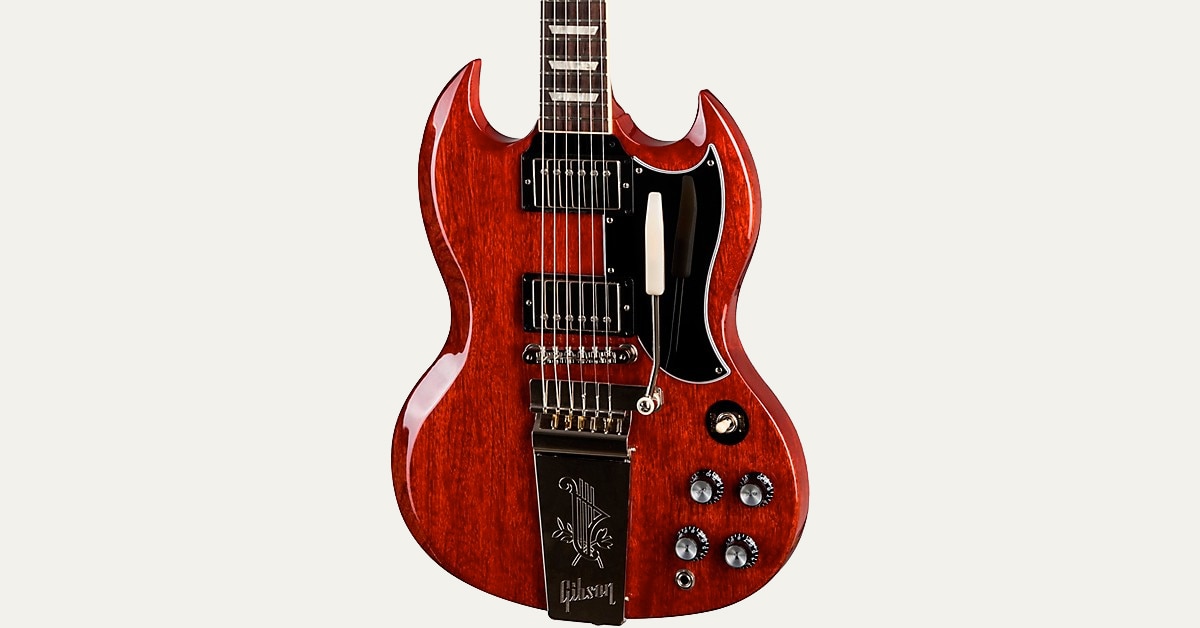Need help choosing the Gibson SG or Epiphone SG electric guitar that's right for you and your budget? You've come to the right place.
Table of Contents
The Gibson SG - A Brief History
Epiphone vs. Gibson USA vs Custom Shop SGs-What's the Difference?
Epiphone SG Models
Gibson USA SG Models
Gibson Custom Shop SG Models
Glossary of SG Terms
Radical in 1961, the SG Still Sets the Bar for Hard Rock Today
To this day, the streamlined looks and sharply defined double-cut body of the SG has maintained its position as a thoroughly modern-looking axe. While sharing much of the warmth of the LP's sound, the SG is appreciated by many rock guitarists for its more articulate "snap", and a little more jangle on the top end. Because of the way the neck meets the body, the SG offers excellent access to the entire fretboard, making it great for soloing and upper-register chord work. And SGs are typically lighter than Les Pauls making them easier to sling during lengthy gigs or recording sessions. Their lighter weight makes SGs very resonant and responsive to what's coming from your amplifier. The thinner, beveled SG body makes it comfortable to hold and play. With its back nestled against your ribcage, you can feel the instrument resonate more fully than with other guitars.
Since its introduction in 1961, the Gibson SG, designed by Ted McCarty, has been adopted as the weapon of choice by countless guitarists. The fast and comfortable neck, throaty pickups, shoulder-friendly weight, and a lower price tag than its stablemate, the Les Paul, all contributed to its ready acceptance. Over the years, Gibson and its value-oriented Epiphone subsidiary have created many variations and models. In this guide we'll help you sort out all the specs and features of the current SG model lineup. You'll also learn a little about the history and lore of this iconic electric guitar along the way.
The Gibson SG - A Brief History
By 1960, Gibson's Les Paul sales were faltering. Aside from a growing perception that the LP was a bit old-fashioned, its heft as well as a hefty price tag were seen as reasons for its decline. To address this, Gibson set out to radically rethink the Les Paul.
The former carved maple arched top was replaced with a thinner, flat-topped solid mahogany body without binding, greatly reducing construction costs. The neck was given a more slender and comfortable profile and repositioned to join the body at the 19th fret versus the former 16th-fret neck joint. Combined with double cutaways on the body and a reduced neck heel, this produced much better access to the upper frets with enhanced speed and comfort. Bevels on the body also contributed to the new guitar's playing comfort.
How the SG Got It's Name
Originally known as the Les Paul (with some radicial changes), it's said that Paul himself was not fond of the new design and asked that his name be removed. There is some debate about this. One story has it that Les Paul was in the midst of a divorce at the time and didn't want his wife to claim a share of the royalties. Whatever the case, Gibson honored his request, renaming the radically re-designed guitar the SG. So, you're next question is probably, "What does 'SG' mean?" The SG name stands for "Solid Guitar." However, it wasn't until 1963 that Les Paul's name was removed from the nameplate and truss rod cover.
Gibson offered four different SG models upon its debut: the no-frills SG Junior equipped with a single P-90 pickup, the SG Special with dual P-90s and optional tremolo, the SG Standard with dual PAF (Patent Applied For) humbuckers and tremolo, and the flagship SG Custom with three PAFs, tremolo with Maestro Vibrola tailpiece and elaborate fretboard and headstock inlays.
Since then, Gibson and Epiphone have produced many SG variants with dozens of pickup and electronics configurations, finishes, and hardware choices, including many different bridge and tailpiece options.
Epiphone vs. Gibson USA vs. Custom Shop SGs - What's the Difference?
Superficially, the specs and features of most SGs seem similar. So, what are the differences between Epiphone SGs, Gibson USA SGs and Gibson Custom Shop SGs? Here's a quick rundown on each:
Epiphone SG Models
Produced in Asian plants, Epiphone SGs involve less hand work and less costly woods, hardware, electronics, and finishes than their U.S.-made counterparts. They offer excellent value for budget-conscious guitarists. Some models have U.S.-made pickups and electronics. Durable polyurethane finishes are typical.
Gibson USA SG Models
Built in Nashville, Tennessee, Gibson USA SG models reflect great attention to detail, and are made with premium-quality woods, electronics, hardware, finishes, and extensive handwork. All USA models have nitrocellulose lacquer finishes that allow the wood to age gracefully and season over time, imparting a more mature, musical tonality.
Gibson Custom Shop SG Models
Handcrafted in Gibson's Nashville Custom Shop, SG Custom Shop models are highly collectible instruments that incorporate the finest woods, electronics, hardware, and embellishments available. They typically have single-piece mahogany bodies and nitrocellulose lacquer finishes with full gloss, vintage original patina, or lightly to heavily aged treatments. Many instruments are meticulous recreations of vintage models or guitars associated with renowned SG players.
Epiphone SG Models
In 1957 Gibson acquired Epiphone, a long-standing rival in the guitar market. After the buyout, Epiphone instruments were built in Gibson's factories and shared many of the same woods and components used in Gibson's product line. Epiphone guitars were usually pretty much identical to their Gibson counterparts apart from their insignia.
Beginning in the 1970s, most Epiphone instruments were built in Japan and later in Korea. Continuing today, Epiphone guitars are built in Asian plants to Gibson's exacting specifications. Having less hand work and less costly woods, hardware, and finishes than their U.S.-made counterparts, Epiphone's SG models are great choices for budget-conscious guitarists.
Let's look at some of the models in the current line-up of Epiphone SGs:
Epiphone G-310 SG
Built to Gibson's strict quality standards, the G-310 offers awesome bang for the buck. Bolt-on neck construction is bulletproof and helps keep the price affordable for the budget-strapped player. Dual open-coil humbuckers and a Tune-O-Matic bridge with stopbar tailpiece serve up authentic SG tone and sustain.
- Alder body
- Bolt-on mahogany neck
- 22-fret rosewood fingerboard
- 2 open-coil humbuckers
- LockTone Tune-O-Matic bridge and stop tailpiece
- Chrome hardware
- Dot inlays
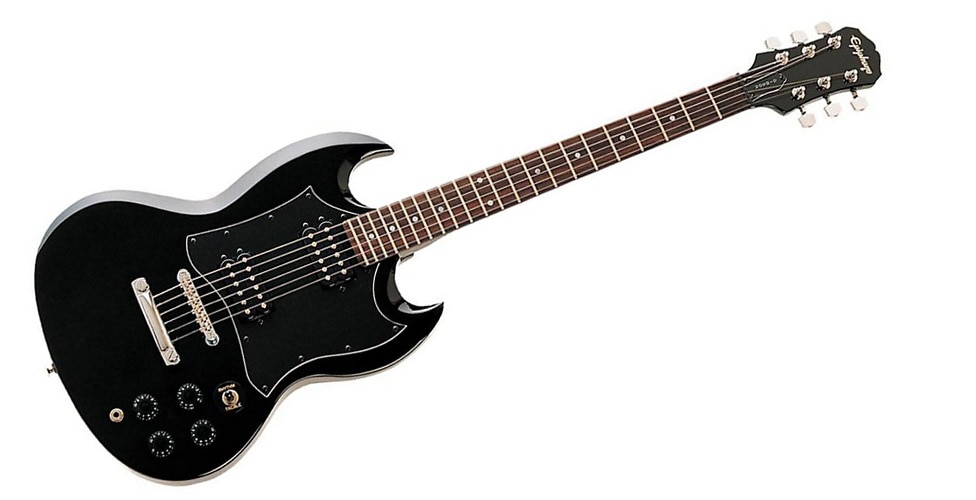
With the Epiphone G-310 SG you get authentic SG tone and sustain without the much steeper price tag of Gibson editions.
Epiphone G-400 PRO
Based on the 1962 SG, it generates all the searing sustain of the original, and goes its predecessor one better with coil-splitting on the dual Alnico Classic Pro humbuckers for punchy single-coil sounds.
- Mahogany double-cutaway body
- 24.75 scale set-in mahogany neck
- Rosewood fretboard
- 22 medium-jumbo frets
- Trapezoid fretboard inlays
- Alnico Classic Pro neck humbucker with coil-split
- Alnico Classic Pro Plus bridge humbucker with coil-split
- LockTone Tune-O-Matic bridge
- LockTone stopbar tailpiece
- Wilkinson Vintage Classics 14:1 ratio tuners
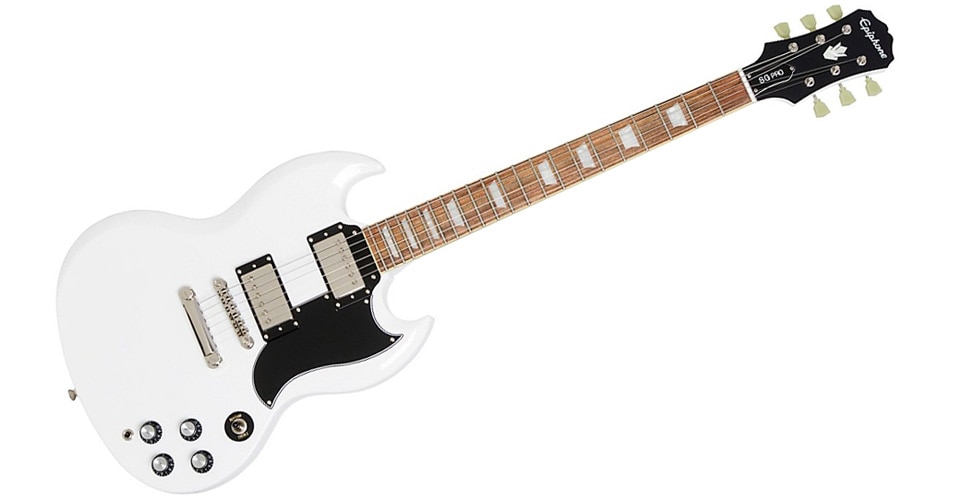
The Epiphone G-400 PRO is modeled on a '62 SG with upgraded coil-split pickups that add single-coil versatility to its traditionally fat humbucker tone and resounding sustain.
Epiphone Limited Edition 1966 G-400 PRO
Original '66 G-400s were enthusiastically received by heavy rockers of the day, and it has gone on to be a much sought-after edition. The Epi update is built using the same dimensions and techniques originally used in Gibson's Kalamazoo plant. It has the fast, slim-taper neck long revered by shredders, and high-output 'buckers that churn out thick, throaty tone.
- Mahogany body
- Mahogany, glued-in neck
- 24.75" scale
- SlimTaper "D" neck profile
- 1.68 nut width
- Rosewood fingerboard, 22 fret
- Fingerboard radius: 12"
- Neck pickup: Alnico Classic humbucker
- Bridge pickup: Alnico Classic Plus humbucker
- Tune-o-Matic LockTone bridge
- Stopbar tailpiece
- Controls: Neck pickup: 1-Volume, 1-Tone/ Bridge pickup: 1-Volume, 1-Tone w/full-size 500K-ohm potentiometers
- Nickel hardware
- 14:1 ratio Grover tuners
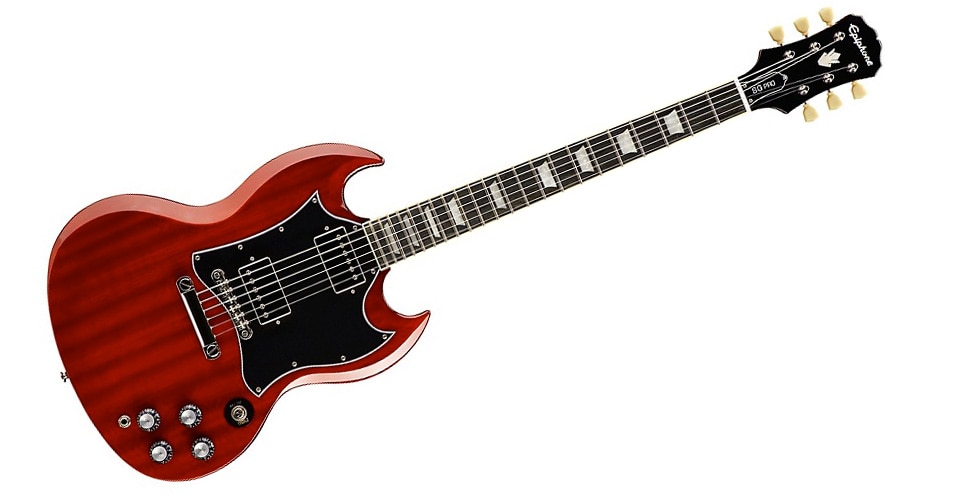
Epiphone builds the Limited Edition 1966 G-400 PRO to original Gibson specs then ups the ante with high-output Alnico Classic pickups for even more snarl.
Epiphone EB-3 Bass
When Gibson ceased production of the Les Paul (temporarily as it turned out) in favor of the SG, the company's bass was also radically revamped to emulate the guitar's design. Bassists such as Bill Wyman of The Rolling Stones, John Entwistle of The Who, and Cream's Jack Bruce all took to the new "SG" bass, creating some of their bands' most memorable work with it. Epi's recreation mirrors the tone and feel of the original at a fraction of the price of the Gibson version or a vintage EB-3. The pairing of a Sidewinder and mini humbucker generate authentic vintage tone while the SlimTaper "D" neck shape offers all the playability of the original.
- Mahogany body
- Mahogany glued-in neck
- SlimTaper "D" neck profile
- 34" scale
- Rosewood fingerboard with trapezoid inlays
- 1.65" nut width
- Sidewinder humbucker neck pickup
- NYT Bass mini humbucker
- Nickel hardware
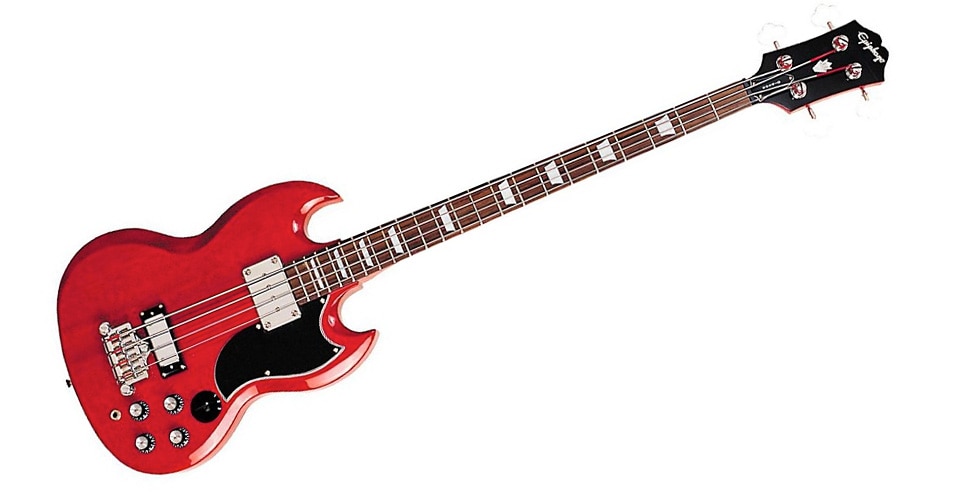
The Epiphone EB-3 Bass is a recreation of the Gibson model that was introduced along with the SG, and was snapped up by premiere bassists of the day including Jack Bruce, John Entwistle, and Bill Wyman.
Gibson USA SG Models
Built in the USA, these SGs reflect meticulous attention to detail, premium-quality woods, electronics, hardware, lavish finishes, and extensive handwork.
With its current line-up of Gibson USA SG models, the company continues to address the needs of two distinct players: the traditionalist who wants all the original 1960s SG mojo, versus the guitarist looking for modern electronic and performance tweaks. Let’s take a look at some of the models.
Gibson SG Standard
Featuring all of the classic look and feel of late '60s SGs, including the "batwing" pickguard, the Gibson SG Standard has a rounded-profile mahogany neck, a bound 22-fret rosewood fingerboard and a solid mahogany body. Loaded with Dual 490R and 490T Alnico 2 humbuckers, the SG Standard is a looker as well as a potent performer.
The SG Standard model is available in Ebony and Heritage Cherry.
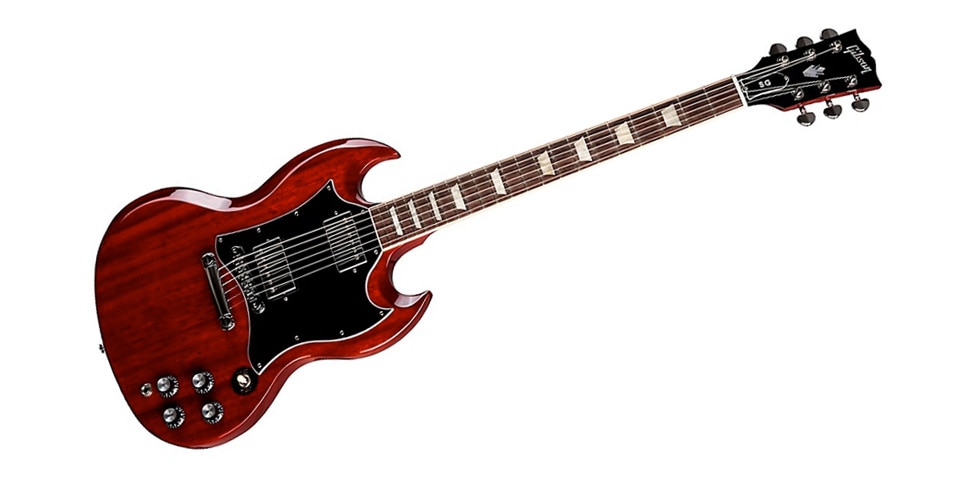
The Gibson SG Standard in Heritage Cherry exudes classic cool.
Gibson SG Standard '61 Maestro Vibrola
Modeled on the '61 SG Standard, the mahogany-bodied SG Standard '61 Maestro Vibrola features 61R and 61T Burstbucker pickups, a 5-ply teardrop pickguard, 22nd fret neck joint, an ABR-1 tune-o-matic bridge and keystone tuners. The classic Maestro Vibrola provides an opportunity to add subtle vibrato to your playing.
The Gibson SG Standard '61 Maestro Vibrola features all the iconic stylings of the '61 SG with the added versatility of the Maestro Vibrola vibrato.
Gibson SG Modern
Matching classic SG looks with the latest in Gibson innovations, the Gibson SG Modern is truly designed for the contemporary player. Featuring a AA figured maple top on mahogany body, it delivers plenty of sustain and resonance. The 24.75" mahogany neck is adorned with a 24 fret, compound-radius ebony fingerboard. The pair of Alnico Burstbucker Pro and Pro+ pickups provide plenty of versatility thanks to the push/pull coil taps.
Versatile electronics, modern looks and more make the SG Modern a great choice for anyone looking for an SG with contemporary updates.
Gibson Custom SG Models
The SG guitars handcrafted in Gibson's Nashville-based Custom Shop are extraordinary in every respect. Each is crafted by a master luthier with the utmost attention to detail, and embellished with high-end appointments such as multi-ply binding and gorgeous inlay work. Many Gibson Custom instruments are meticulous recreations of vintage models or instruments associated with renowned SG players. Only the finest components and woods are hand-selected for each Custom Shop creation, making them worthy of the most demanding collectors and musicians.
You'll find our current selection of Custom Shop SGs together with other investment-grade instruments from Gibson in our Private Reserve Guitars Collection. Our Guitar Advisors are available by telephone at (866) 926-1923 or via Skype to assist you with in-hand descriptions of individual instruments and detailed photos. Our professional setup service ensures a perfectly intonated guitar, ready to play upon arrival.
Shop Musician's Friend's selection of Gibson Custom SG models at Private Reserve Guitars. Our Guitar Advisors are available by telephone at (866) 926-1923 or via Skype to assist you with in-hand descriptions of individual instruments and detailed photos.
After reading this guide, if you're still not sure which Gibson or Epiphone SG is right for you, we invite you to call one of our friendly and knowledgeable Gear Heads
Glossary of SG Terms
'60s neck: the flatter, slimmer neck profile introduced when the SG debuted. Also called the slim-taper neck.
490R: neck (or R for rhythm) pickup fromGibson's lineup of Modern pickups that use Alnico 2 magnets providing traditional humbucker tone with enhanced highs. Usually paired with a 490T bridge pickup.
490T: bridge position (or T for treble) pickup from Gibson's lineup of Modern pickups that use Alnico 2 magnets providing traditional humbucker tone with enhanced highs. Usually paired with a 490R pickup.
496R: from Gibson's lineup of Modern pickups, it features a ceramic magnet for hotter output. The 496R is used in the neck position. The R stands for "Rhythm"-which is how the neck position is labeled on the pickup selector switch on an SG. The 496R is usually paired with the 500T pickup used in the bridge position ("T" for "Treble" pickup switch setting).
498T: bridge position pickup from Gibson's Modern line of pickups that uses ceramic ringed magnets for higher output, enhanced mids, and more highs (and less bottom than the alnico magnet BurstBucker).
500T: Gibson bridge position pickup from its Modern line uses ceramic ringed magnets for higher output and more highs, increased sustain and definition (and less bottom than the alnico magnet BurstBucker). Usually paired with 496R neck position pickup.
'57 Classic: from Gibson's line of Historic Humbuckers. Uses Alnico 2 magnet material and balanced coil windings to produce vintage sound with rich, warmer tones.
'57 Classic Plus: from Gibson's line of Historic Humbuckers. Uses Alnico 2 magnet material and slightly overwound coils for increased output.
A maple: single A rating for maple means the wood is perfectly clear with no mineral streaks or other defects. Has little or no figuring or "flame."
AA maple: predominantly figured, or what many call "flamed"-contains a fair amount of figuring (more than half).
AAA maple: significantly figured or flamed
AAAA maple: very heavily figured or flamed
ABR-1 bridge: same as Tune-O-Matic bridge. This was the part designation of Gibson's first fully adjustable bridge. Used in conjunction with a separate stop tailpiece. See Tune-O-Matic.
Abalone: an ear-shaped shell lined with mother-of-pearl found in a sea mollusk-used for guitar inlays.
Aged plastic parts: treated to make them look as if they have seen extensive use. For example, numbers on knobs may be discolored and faded.
Alnico magnet: made with an alloy of aluminum, nickel, and cobalt, from which its name is derived. Used for magnets in pickups. Alnico 2 produces a sweet, traditional humbucker tone, while Alnico 5 (also designated Alnico V) is a little stronger, and produces a brighter, hotter tone.
Appointments: the visual aspects of a guitar's body, neck, and headstock that enhance the guitar's look and value. Appointments include binding, inlays, and hardware.
Auto trim tuners: Tuning machines with built-in cutters that trim excess string left hanging out of the tuning post.
Beveled: square edges on a guitar body, pickup or other surface that have been reduced to sloping edges. Bevels help the guitar to nestle more comfortably against the guitarist's rib cage.
Bigsby vibrato: a tailpiece with a bar that lets guitarists raise or lower the tension-and the pitch-of the strings. Also called "tremolo bar" or "whammy bar." The Bigsby vibrato tailpiece was used by guitarists such as John Cippolina of Quicksilver Messenger Service on his customized SG.
Binding: decorative appointment that covers the join of the body and the top or the join of the fretboard and the neck. Also used to cover the join of the fretboard to the neck. Ply refers to the number of layers in the binding, e.g. 3-ply or 7-ply.
Bolt-on neck: a neck that is attached into a fitted slot in the body by means of three or four wood screws running through the back of the body and into the back of the neck. This method of attaching necks was critical in the development of the electric guitar because it reduced production costs, making electric guitars more affordable. A bolt-on neck can be replaced, adjusted, or repaired with far less skilled labor than is required for other neck types. Bolt-on necks are used on some low-cost Epiphone SG models.
Burst: abbreviation of the word sunburst. See Sunburst finish.
BurstBucker: the name for Gibson pickups from its Historic Humbucker lineup.
BurstBucker Type 1, Type 2, and Type 3 feature Alnico 2 magnets and are replicas of "Patent Applied For" humbucker pickups found on early Les Pauls. All three types feature an airy tone. Type 1 pickups have unbalanced coils that are slightly underwound. Type 2 has coils that are wound to specification. Type 3 has unbalanced coils that are slightly overwound. They are used on some SG models.
BurstBucker Pro: pickups feature Alnico 5 magnets and wax potting and have an enhanced "Patent Applied For" tone with more bite and brilliance.
Carved maple top: a 3/8 piece of maple carved into a curved shape and laminated to the back section of the guitar body (the back is usually made of mahogany).
Carved non-figured maple top: maple top that does not have wood with figuring or "flame."
Ceramic magnet: used in pickups such as Gibson's 500T to produce a "hotter" output. See Output and Alnico magnet.
Chambered: a guitar body with carefully selected cavities, or dynamic sound chambers routed into the body. Not to be confused with "weight relief" holes that are drilled. Seen in Les Paul models.
Double-cut: a guitar that has two cutaways.
Double-potted: a pickup that has been dipped into wax twice for a tighter seal to ward off unwanted vibrations that can cause microphonic feedback.
Ebony: very hard, dense wood used in fretboards of higher-quality guitars, such as the Gibson SG Custom.
Fingerboard: See fretboard.
Finish: protective and decorative coating applied to the wood body, neck, and headstock of the guitar
Fretboard: also called fingerboard; made of rosewood or ebony on SGs and laminated on top of another piece of wood, usually mahogany. Metal frets are carefully hammered into the fretboard.
Fretboard Radius: The measure of the curvature of the top of the fretboard from edge to edge is often incorrectly referred to as the "neck radius". Actually, the correct terminology would be either fretboard or fingerboard radius and the actual neck shape and size should be called the "neck profile."
The fretboard radius can be found by first drawing a circle with a corresponding radius (the radius is the distance from the center of a circle to its outer edge), and then cutting out a portion of that circle corresponding to the width of the fretboard. For example, if you have a 7-1/4-radius fretboard, you could tie a piece of string to a pencil, measure out a length of string to 7-1/4, and put a thumbtack on the other end of the string. Secure the tack, stretch the string, and draw a circle. By cutting out a piece of that circle the width of your fretboard, you will have an example of an arc with the same curvature as that of your fretboard radius.
Fret size: determined by the height and width of the fret wire. Low frets, while easy on the fingers, can make it hard to bend string. High frets result in a higher action. Narrow frets tend to wear faster; wider frets tend to be more durable. Frets that are high and narrow are very popular. See jumbo frets.
Gold hardware: an appointment found on higher-value SGs such as the Custom. Gold resists rust and corrosion.
Green tuning keys: also called "green vintage tuning keys," this is a patina applied to tuning keys to make them look aged.
Grover tuners: a higher quality brand of tuner than the standard-issue tuners. They have enclosed, permanently lubricated machine heads so they tune more smoothly and hold the strings in tune longer. Grover has been making machine heads for stringed instruments since the late 1800s.
Headstock: the uppermost portion of a guitar neck, where the tuners are mounted.
Humbucker: pickup used in most SG guitars. The humbucker pickup has two wound coils next to each other that are wired out of phase. This eliminates or reduces most electrical hum to which single-coil-pickups are prone. See Seth Lover and P-90.
Intonation: the ability of a guitar to produce notes that are in tune from fret to fret all the way down the neck. Intonation can usually be adjusted from the saddles on the bridge.
Jumbo Frets: also called wide frets or super-size, refers to width and height of the fret wire. Preferred by some lead players who do lots of string bending. Higher fret wires give the player a greater range of string bending. See fret size.
Inlays: decorative appointments found in the fingerboard and headstock that are usually made of mother-of-pearl, abalone or acrylic material. SG inlays include block and trapezoid shapes.
Kill switch: a switch that completely cuts off signal from all pickups.
Kluson tuners: a higher-quality brand of tuner than standard-issue tuners. Has better materials and construction so that they tune more smoothly and hold the strings in tune longer.
Lacquer (also called nitrocellulose): clear or colored coating that is sprayed onto the guitar body in several coats that produces a hard, durable finish.
Les Paul: legendary guitarist and inventor of multitrack recording. One of the pioneers of the solidbody electric guitar.
Limited edition: a guitar with a unique set of features produced in limited quantities. Many times the serial number is hand stamped on the back of the neck to indicate where in the limited series that particular guitar was produced-a feature sought by collectors to enhance the guitar's value.
Long-neck tenon: also called long tenon or deep tenon-the part of the neck that extends into the body for a more solid join when neck and body are glued together.
Lyre Vibrola: trapeze-style tremolo tailpiece that allows altering string tension to produce pitch-shifting effects. This type of string termination swings freely from the tail of the guitar, freeing the top from the leverage of string tension.
Maple: a very dense, hard wood used primarily for the top of most Les Paul models and some SG models. The maple is carved into a 3/8-thick top that is laminated to the back (which is usually made of mahogany).
Mahogany: a very dense, strong, but not extremely hard, hardwood used primarily for the body and the neck of SGs. Emphasizes midrange and bass tones for mellower or darker tone.
Midrange: the middle of three ranges of tonal frequencies: low, midrange, and high. The overall sonic character of a guitar is determined by how strongly it produces sound in each of these three ranges. Generally, a good guitar will be able to provide a mix of all three. The exact mix-how much midrange versus highs, for example-is mostly a matter of individual taste or preference. Some of the features that affect tonal character of an SG include the types of wood used, how the guitar is constructed, the type of pickups, materials used in the bridge and nut, and the gauge and composition of the strings.
Mini-humbuckers: smaller version of standard humbuckers, first used in the 1968 Les Paul Deluxe. The sound is described as a sweeter, more "centered" sound with greater emphasis on midrange.
Neck-through (Neck-thru): design in which the guitar is built around a single column of wood that extends from the tip of the headstock through to the strap button at the tail. This column can either be a single piece or several pieces laminated together side-by-side. The wings of body wood are glued onto the sides of this central column of wood. Neck-through bodies produce maximum sustain and have the advantage of eliminating the large heel where the neck meets the body, thus providing the freest access to the higher register frets. Neck-through guitars are more expensive to manufacture than bolt-on necks.
Nitrocellulose lacquer finish: a fast-drying synthetic finish used commonly in the 1950s and 1960s, it is now mostly used for reissue guitars from those decades. See thin nitrocellulose finish.
Nut: located where the headstock joins the neck, determines the spacing of the string and their height above the neck. A string nut can be made of bone, graphite, brass, nickel, Corian, or plastic.
Nut width: the distance across the top of the fretboard which determines the space between individual strings. Players with bigger hands usually prefer a wider fretboard.
Output: the amount of electrical signal produced by a guitar pickup. Higher output (or "gain") means the pickup can more easily overdrive the amplifier and produce hard-edged or distorted guitar tones favored by many rock guitarists. An example of a high output-pickup is the 500T used in the Les Paul Classic.
P-90: a single-coil pickup that comes in two shapes: dog-ear and soapbar. The SG Special had dog-ear P-90s, and the P-90 is found on some Gibson USA and Custom Shop SGs. It produces a warm, soulful, and historic '50s tone.
"Patent Applied For": this legend was stamped on early versions of the Gibson humbucker. It was the sound of these pickups on the "Sunburst" Les Pauls from 1958 through 1960- especially when played through a Marshall amp-that produced the creamy sustain and warm distortion featured on many classic blues and rock recordings in the late '60s. In its reissues of vintage guitars, Gibson strives to achieve the historically-accurate "Patent Applied For" tone in its BurstBucker Type 1, 2, and 3 pickups and what Gibson describes as "enhanced Patent Applied For tone with more bite and brilliance" from its BurstBucker Pro pickups.
Pickguard: usually made of plastic (celluloid, vinyl, PVC, acrylic) or laminated material such as parchment. They can also be made of plexiglas, glass, wood, fabrics, metals, or plywood. Pickguards may be made of a single layer (ply) or multiple layers, for example 3-ply or 5-ply. Pickguards are usually located below and/or around the strings to prevent damage to the finish caused by the guitarist's strumming or picking.
Ply binding: binding that has multiple layers, such as 3-ply or 5-ply binding. Multi-ply binding is more attractive than simple binding and is found on higher-end guitars.
Pot: potentiometer-an electrical component used to control volume and tone that usually incorporates an adjustable knob or lever.
Quilt top: the pattern of figuring or flame on a maple top that resembles a quilt.
Radius: See neck radius.
Rosewood: wood used on fingerboards on some SG guitars. Higher-cost guitars typically have ebony fingerboards.
Rounded neck: describes the neck profile on some vintage '50sGibson guitars as opposed to the slimmer, flatter shape on '60s SGs.
Scale length: the measured distance of the vibrating string length between the nut and the saddle. The 24-3/4 scale length of the SG is shorter than the 25-1/2 scale length on the Fender Stratocaster (and Telecaster) which was taken originally from the standard scale length for steel-string acoustic guitars. The shorter scale length of the SG (and Les Paul) provides less tension making it easier to bend strings.
Seth Lover: Designer who developed and patented the humbucker pickup first introduced in the 1957 Les Paul.
Set-in neck: neck that is glued to the body, as opposed to a bolt-on neck. See through neck.
Signature guitar: Gibson Custom Shop models built to famous guitarists' personal specifications.
Single-coil: a guitar pickup that has only one coil of wrapped around a single magnet. The sound produced by a single pickup is brighter with less midrange and bottom than a humbucker and is more prone to hum. See P-90.
Slim '60s neck: a slimmer, flatter taper or neck profile, than the rounded '50s neck.
Slim-taper neck: flatter and thinner neck preferred by some players over the rounded neck.
Stopbar tailpiece: combination bridge/tailpiece introduced on the Les Paul in 1954, replacing the trapeze tailpiece. It is used on many SG models.
Strap Lock: prevents guitar strap from slipping off the guitar's strap button.
Sunburst finish: A finish technique in which the color of the guitar is lightest at the center darkening gradually as it approaches a dark rim. The wood grain is often visible in the lighter areas of a sunburst guitar top.
Thin nitrocellulose lacquer finish (also called a "nitro" finish): ultrathin, ultralight finish treatment that creates the patina of a gently aged vintage guitar. The process is expensive because it takes weeks to apply. A thin nitrocellulose finish allows the wood to breathe and gets thinner over time. The best finish for tone, many feel.
Three-way switch: found on most guitars that have two pickups, it controls which pickups are active-switching positions are usually 1) bridge pickup, 2) bridge and neck pickups 3) neck pickup.
Through neck (also known as neck-through or neck-through-body): the wood used for the neck runs the entire length of the body. The rest of the body is composed of "wings" glued or laminated to the neck. A through neck results in improved tone and sustain. Because a through neck is more complex to construct it is more costly and so is mostly found on high-end guitars. See also Neck-through.
Top hat knobs: Type of volume and tone knobs that resemble a top hat. Found on vintage SGs and their reproductions. They come in either black or gold. Vintage top hat knobs age to an amber color.
Transparent colors: a thin lacquer finish that lets the natural wood grain of the guitar's top show through.
Tune-O-Matic (also abbreviated TOM): Gibson's name for its adjustable bridge that was introduced in the 1954 Les Paul Custom. The length and height of individual strings can be adjusted for better intonation. It is used on many SG models.
Tuners: tuning pegs (also called tuning keys or machine heads) used to raise or lower the tension and therefore pitch of individual guitar strings. See Grover and Kluson.
VOS - Vintage Original Spec: Series of reissue guitars produced by the Gibson Custom Shop to the exact specifications of original vintage guitars. VOS treatment may include aging of the guitar's finish, hardware, and plastic parts.
Waxed pickups: during construction the pickup is dipped (or "potted") in wax to eliminate microphonic feedback which is caused by unwanted vibrations passing from the guitar body to the pickup. Used on all Gibson pickups except BurstBucker Type 1 and Type 2, which are historically-accurate replicas of "Patent Applied For" pickups found in vintage Les Paul and SG models. "Patent Applied For" pickups were not wax potted.
Wide frets: Until 1959, most Gibson electric guitars had shorter, narrow frets. Some players prefer wide frets that they feel are more comfortable as their fingers move along the strings. Some guitarists prefer short wide frets, finding it makes the guitar easier to play.
Zebra pickups: resulting from mismatched colors of pickup bobbins. Originally found in late 1950s Sunburst Les Pauls, the bobbins became visible when players removed pickup covers to supposedly enhance the sound. Zebra pickups are prized by collectors because they are a further indication of a vintage guitar's authenticity. Some modern Gibson SG models are equipped with them.





































































































































